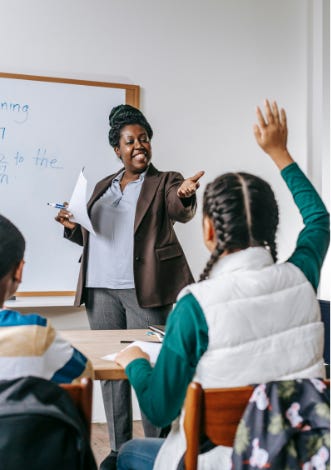The Teacher's Balancing Act: Respect Without Fear, Support Without Friendship
Finding the sweet spot between being liked and being respected in the phlebotomy classroom
by Shanise Keith • August 18, 2025
It was pretty early on in my years of teaching when I learned one of the most important lessons of my career. A student I'll call Maria had been struggling in my phlebotomy program for the last couple of weeks. Her lab work was sloppy, she was frequently late, and she seemed disengaged during lectures. My first instinct was frustration – here was someone who wasn't taking her education seriously. We have all dealt with this type of student, they just don’t seem to care sometimes. That is what I thought was happening here.
Then one day after class, Maria approached me with tears in her eyes. Her mother had been diagnosed with cancer, and she was working more hours at her job on the weekends to help support her family, along with taking our evening phlebotomy class. She was a high school senior dealing with some of the worst news someone can get. She was working herself to death while trying to keep up with school. She wasn't making excuses – she was drowning, and she needed help figuring out how to stay afloat.
That conversation changed how I viewed my role as an educator. I wasn't just teaching venipuncture techniques and laboratory safety. I was working with real people facing real challenges, people who needed both high standards and genuine compassion.
Over my years of teaching, I've watched too many instructors fall into one of two traps. Some become so focused on being liked that they lose all authority in their classroom. Others become so rigid in their approach that students are afraid to ask questions or admit when they're struggling. Neither approach serves our students well.
Here is where we can fall into the “friend trap.” I get it – we want our students to like us. Teaching can be isolating, incredibly challenging, and having a tough class can make you question your sanity. When students laugh at our jokes or seem genuinely happy to see us, it feels good. But there's a dangerous line between being approachable and being a friend.

I've seen instructors who share way too many personal details about their lives, who laugh off missed assignments and accept excuses without question. I’ve even seen them add current students to their social media accounts and hang out with them outside of class. They think they're being supportive, or being the “cool” teacher, but what they're actually doing is undermining their own authority (along with being very unethical).
When students start seeing you as a peer, a friend, or a “bestie” rather than an instructor, several things happen. They stop respecting deadlines because "you're cool with it." They begin challenging your expertise because friends can disagree about things. Most importantly, they lose the structure they need to succeed in a demanding program like phlebotomy.
On the other extreme, I've observed instructors who rule their classrooms with rigid authority. The “iron fist” trap. These teachers don't smile enough, don't show flexibility, and treat any struggle as a personal failing. Students in these classrooms are afraid to ask questions, afraid to admit when they don't understand something, and afraid to seek help when they need it most.
This approach might look effective on the surface – students are quiet, they follow rules, they complete assignments. But fear-based learning doesn't create competent, confident healthcare professionals. It creates people who are good at following orders but terrible at critical thinking.
In phlebotomy, we need practitioners who can think on their feet, who can communicate with patients, and who feel confident seeking help when they encounter something unfamiliar. You can't build those skills in an environment where students are afraid to speak up. Students should be encouraged to ask questions and be excited to learn new things. Not scared of angering an instructor.
I once observed a classroom where students were so intimidated by their instructor that they never asked questions during venipuncture practice. They were making the same mistakes over and over, but they were too scared to admit they needed help. The instructor thought silence meant conformity, that they had mastery. In reality, it meant students were learning incorrect techniques that would follow them into their careers.
So how do we find “that sweet spot?” During my first couple of years of teaching I definitely had classes where I struggled with being the “fun” teacher, and others where I needed to relax a little bit. Finding your balance is hard. I remembered my favorite teachers from when I had been a student and wanted to be like them. It backfired and caused me to struggle with a bit of an unruly class. I never wanted to be one of the teachers I hated or feared, but in my attempts to not make the same mistakes I had made when things were too lax, I fell into being overly strict. I could tell students thought I wasn’t being fair or forgiving enough when they had extenuating circumstances. It took some time, but I finally found my footing and was able to create the environment I wanted.
The balance we're looking for is what I call "professional warmth." Students should feel safe in your classroom – safe to ask questions, safe to make mistakes while learning, and safe to seek help when they need it. But they should also understand that you have high expectations and that meeting those expectations is non-negotiable.
We educators are here to serve our students. We should build them up, make them believe in themselves. We should enforce the rules and keep the classroom safe and orderly, but also not be afraid to show excitement for a student who has a successful blood draw, or passes a test they had struggled with. We should be genuine, kind, caring, but students don’t need to hear about our drama outside of class. School should be all about them, and their learning experience, not about us.
Here's how I try to achieve this balance:
- Be consistently fair. Students need to know what to expect from you. If you're strict about attendance one day and lenient the next, you create confusion and resentment. Establish clear policies and apply them consistently to everyone.
- Set high standards, then support students in meeting them. Don't lower your expectations – raise your level of support. If students are struggling with a concept, find different ways to teach it. Offer extra practice time. Connect them with tutoring resources. But don't compromise on the standards they need to meet.
- Show interest in their success, not their personal lives. Ask about their learning goals, celebrate their improvements, and acknowledge their hard work. But maintain professional boundaries. You're their teacher, not their friend or their therapist.
- Be approachable but not available for everything. Students should feel comfortable approaching you with academic questions or concerns about their progress in the program. But make it clear that you're not available for personal problems, relationship advice, or constant reassurance about every small worry.
Sometimes students will confide in us about personal challenges. When Maria told me about her mother's diagnosis, I had a choice to make. I could have taken the approach that personal issues shouldn't affect academic performance, or I could have tried to become her emotional support system.
Instead, I chose a middle path. I listened without trying to fix her problems, connected her with the school counselor, and then worked with her to identify practical academic accommodations that could help her succeed despite her challenging circumstances.
This is where professional warmth becomes crucial. Students need to know that while you care about their success, you're not equipped to handle their personal problems. The kindest thing you can do is connect them with appropriate resources while maintaining your role as their educator.
When students are struggling, I give them the benefit of the doubt. If someone's performance suddenly drops, if they start missing classes, or if they seem disengaged, I pull them aside for a private conversation. Sometimes there's a legitimate crisis that requires accommodation. Sometimes they just need to know that someone noticed and cares about their success.
But I make it clear that while I'm willing to work with them on academic solutions, I can't solve their personal problems. That's what counselors, advisors, and support services are for. There have been times where it is in the students’ best interest to drop the class and come back when they have the capacity for it. There have also been times where a student chooses to stick it out and end up succeeding and doing very well in the class. My heart swells just thinking about the difficulties that I have seen students overcome, to go on and be a successful phlebotomist shortly thereafter.
When you find this balance, amazing things happen in your classroom. Students feel safe enough to admit when they don't understand something, which means you can actually help them learn. They respect your expertise and authority, which means they take your instruction seriously. And they trust you enough to seek help when they need it, which means you can guide them toward appropriate resources.
Most importantly, you're modeling the kind of professional relationships they'll need to build throughout their healthcare careers. They're learning how to be warm and compassionate with patients while maintaining professional boundaries. They're learning how to seek help when they need it without expecting others to solve their problems for them.
Years later, when former students contact me, they tell me how much they enjoyed the class, how they made friends and had a great experience. I have thank you cards that make me tear up, messages about how I was their biggest cheerleader when they needed it most. But here's what makes me most proud - they also talk about how prepared they felt for their careers, how confident they became in their skills, and how the standards I held them to helped them succeed in demanding healthcare environments.
That's the kind of legacy every educator should want – to be remembered not just as someone students liked, but as someone who genuinely cared about their success and pushed them to become their best professional selves. The goal isn't to be unmemorable or cold. The goal is to be the teacher they remember fondly because you helped them achieve something they didn't think they could do.
My favorite thing as a teacher was to see the growth of a struggling student as they became confident and learned new skills. Watching their eyes light up when they understood a concept, or to see the joy on their faces when they nailed a tough stick. It made all the less enjoyable parts of my job worth it.
Teaching healthcare professionals isn't about being popular. It's about creating an environment where students can develop the knowledge, skills, and confidence they'll need to provide excellent patient care. That requires a delicate balance of support and challenge, warmth and professionalism, flexibility and consistency.
Our students don't need us to be their friends – they have friends. They don't need us to be their therapists – we're not qualified for that role. What they need is for us to be professional educators who care deeply about their success and hold them to the standards they'll need to meet throughout their careers.
When we get that balance right, we do more than teach phlebotomy techniques. We help shape the kind of healthcare professionals our patients deserve.
To check out this blog post on our website (phlebotomy.com) click here.
What strategies have you found most effective for maintaining professional boundaries while still supporting student success? I'd love to hear about your experiences balancing authority and approachability in the classroom.
Related Posts and Information
overall rating: my rating: log in to rate
student educational educator professional professionalism classroom



